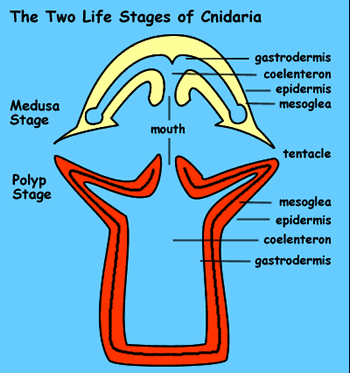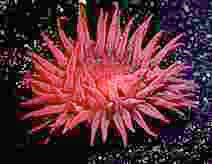|
|
Cnidaria
Members of the Phylum Cnidaria include the Anemones and are grouped with the soft and hard corals and the hydroids. Cnidarians all have a life cycle of two forms. One is a free-swimming jellyfish medusa stage and the second is an attached polyp stage.
Cnidarians have a radially symmetrical body shape with a mouth surrounded by rings of tentacles. They all have stinging cells (poison-bearing nematocyst barbs) to harpoon and immobilise prey.

The two life stages of Cnidaria have similar simple body parts. In the free-swimming medusa stage, such as jellyfish, the body shape is "umbrella-like" with a mouth at the base.

The mouth opens into the stomach called the coelenteron,. This structure is where the group gained its earlier name Coelenterate.
The coelenteron is a gastrovascular cavity which also acts as an alimentary system, a circulatory system and a coelom.
Question:
Check what these words mean ?
The body wall has three layers. There is an outer cellular epidermis, an inner cellular gastrodermis and a complex gelatinous layer between called the mesoglea.
The second life stage is a polyp, which is attached to the substrate. It is a hollow and cylinder-shaped, with a mouth surrounded by tentacles at the top. In colonial forms, such as coral animals and zoanthids, the column extends as a tube to connect all the members of the group.
If there is both a medusa and a polyp in the life cycle, the medusa develops as part of the colony, but breaks away and swims to grow to sexual maturity. Most medusa have separate sexes. The eggs are fertilised after they are shed into the water.
The fertilised eggs usually grow into the polyp form, which in turn may break off parts to form multiple small medusas in a process of asexual division.
Question:
Can you think of reasons why one Cnidaria stage uses a sexual way of reproducing, while the other stage uses a non-sexual way of reproducing ?
 For
some Cnidaria forms, the juveniles may remain in the coelenteron
and be brooded there, such as in the Waratah
Anemone, Actinia tenebrosa.
For
some Cnidaria forms, the juveniles may remain in the coelenteron
and be brooded there, such as in the Waratah
Anemone, Actinia tenebrosa.
In Cnidaria there are groups that are primarily medusoid in life style, with only a brief, insignificant polyp stage, and others that are primarily polyps, with only a brief medusoid life-stage.
The above description is a simplified cnidarian life story and there are many variations within the different groups.
The Phylum Cnidaria was once called Coelenterata, which also included the Ctenophora, or "comb jellies" or "sea gooseberries". Animals in the new Phylum Ctenophora do not have stinging cells.
Waratah
Anemone
Eastern Sand Anemone
Home
Page
Taxonomy
Biogeography
Rocky Shores
Tidal Levels
Intertidal Zonation
Environmental Factors
Biological
Factors
Feeding Relationships
Activities
Glossary
References
 Life
on Australian Seashores
Life
on Australian Seashores
by Keith Davey (C) 2000
Learning Consultant
- Media
The University of Newcastle
email at australian_seashores@hotmail.com
Scientific Consultant: Phil
Colman
site created 01.01.98 : updated 01.04.2000
